The Imperiled Giants of the Mekong
By Zeb Hogan, Peter Moyle, Bernie May, Ian Baird
Ecologists struggle to understand—and protect—Southeast Asia's large migratory catfish
Ecologists struggle to understand—and protect—Southeast Asia's large migratory catfish

DOI: 10.1511/2004.47.228
The Guinness Book of World Records lists the Mekong giant catfish as Earth's largest freshwater fish. This species (Pangasianodon gigas), which grows as fast as a bull and looks a bit like a refrigerator, can measure 3 meters in length and weigh up to 300 kilograms.
Called the "king of fish" in Cambodia, "buffalo fish" in Thailand and Laos, and "blubber fish" in Vietnam, this catfish is well known throughout Southeast Asia. Only the caviar-producing sturgeon, goliath catfish of the Amazon and a few species of poorly understood freshwater sting rays rival the Mekong giant catfish in size. In Europe, the Wels catfish (Silurus glanis) reportedly once grew to a monstrous 5 meters in length, but today a 2-meter specimen is considered remarkable.
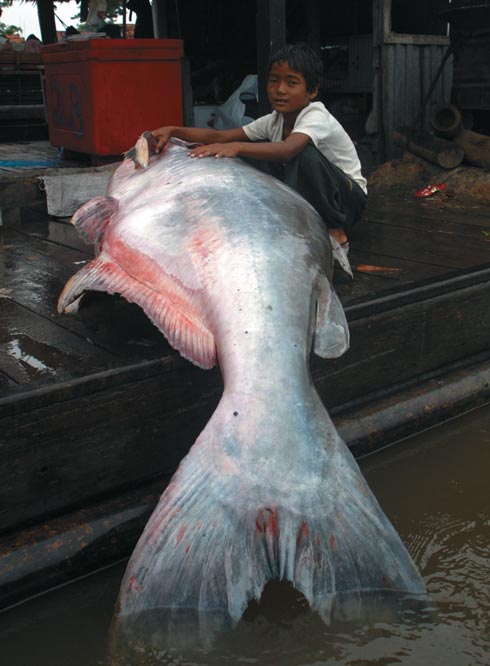
A century ago, the range of the Mekong giant catfish spanned the entire length of the river and its tributaries from Vietnam to southern China. But in the 1930s and '40s, this species began disappearing, first from the segment of the Mekong that flows between Thailand and Laos and later upstream, in northern Laos. During recent times, the status of P. gigas has become extremely precarious. For example, in Chiang Khong (northern Thailand) and across the river in the Houay Xai district (Laos), the 1990 haul included just 69 of these fish. The catch from this stretch of river has fallen considerably since then, and over the past three years local fishers have not reported a single one. Noting this absence and similar patterns unfolding elsewhere, we estimate that the total number of these giant catfish has decreased by 90 percent or so during the past two decades.
Efforts to save this fish from extinction will hinge on many factors—including how well biologists understand the migratory behavior of these animals. Using a variety of approaches, we have endeavored to provide such knowledge. Here we relate how we became involved in this effort and where that journey of discovery has taken us.
In 1996, one of us (Hogan) received a Fulbright scholarship for graduate study at Chiang Mai University in Thailand. During his year in Chiang Mai, he met another of the authors (Baird, a geographer and fisheries biologist then working in southern Laos with the Lao Community Fisheries and Dolphin Protection Project), who suggested to Hogan that he focus his graduate research on the threats to various fishes of the Mekong ecosystem.
At the time, this river was gaining recognition as the most important natural resource in the region, because it provides up to two million tons of food (both animal and plant) for rural people each year and because only the Amazon and the Congo can boast a greater diversity of freshwater species. But the Mekong also faced new threats. Just a year or so earlier, the Mekong River Commission, a body created by the four countries bordering the lower Mekong (Vietnam, Cambodia, Laos and Thailand), coordinated a study to consider building 12 hydroelectric generating stations. According to plans, the dams would stand, on average, about 35 meters high. The slack water behind many of these enormous concrete constructions would stretch for roughly 100 kilometers upstream, representing, in total, more than half of the length of the Mekong River along the span of the slated projects. It was obvious that these dams would have serious environmental consequences. The Commission found, for example, that
[a]ll of the proposed dams will block fish migration. This one impact alone may cause the wholesale decline in the fishery throughout the lower Mekong River. Blocking migration cuts out a critical link in the biological chain of migrating species. While it is possible that some species may find alternative spawning and rearing areas, there is no data to support such a possibility. It is not known how far certain species migrate [or] whether stocks can continue … to function between dams, because stocks and their migration patterns have not been identified.
The urgent need for even this basic knowledge prompted Hogan to begin searching for ways to chart fish movements through the Mekong river system, an effort that would end up engaging all of us in one way or another.
Hogan began by learning the Thai language. Then, with a small grant from the Wildlife Conservation Society, he traveled to towns along the Thai section of the river to record the species for sale at local fish markets. During this time, he narrowed his focus to the dozen or so Mekong catfish species in the family Pangasiidae, which were relatively common, important commercially and interesting ecologically. What is more, the installation of dams was thought to pose a particular threat to these fish, given their highly migratory behavior, adaptation to the natural variation in river flow, and sensitivity to water quality and temperature.
What he found generally supported what was already known about Asia's pangasiid catfish: They are seasonal spawners, grouping together in May, June and July to breed at the beginning of the rainy season. Catches of Mekong catfish peak at this time, when most of the fish apparently migrate in schools up the Thai-Lao segment of the river.
Hogan couldn't describe specific migratory patterns just by inspecting the offerings in fish markets, but these surveys were nevertheless valuable. While traveling from town to town, he had a chance to learn about the fisheries firsthand and to chart the distribution in space and time of various species of Pangasiidae from the border between Isan, Thailand, and Champasak Pro-vince, Laos, in the south to the Golden Triangle region in the north.
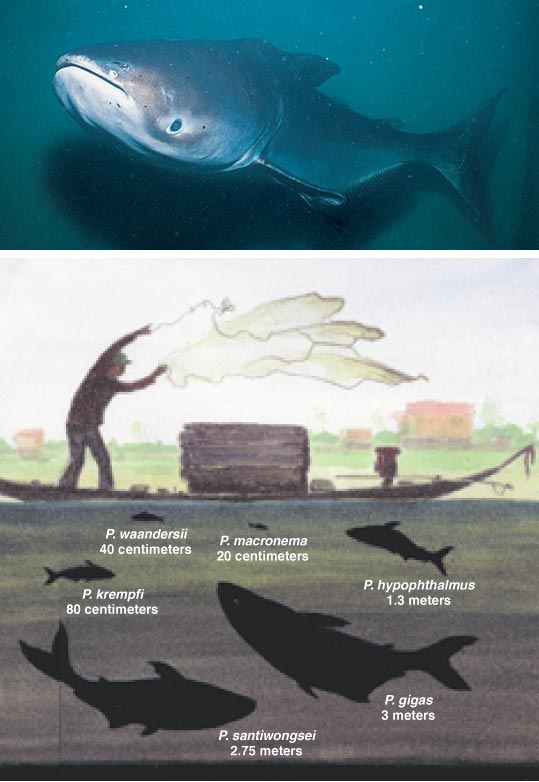
He noted, for example, that the Mekong giant catfish and the slightly less gargantuan "dog eating" catfish (Pangasius sanitwongsei) appeared in the northern section of the river between Thailand and Laos in April, May and June. Smaller species, including the mouse-faced catfish (Helicophagus waandersii), the snail-eating catfish (Pangasius conchophilus) and the whiskered catfish (Pangasius macronema), inhabited the middle stretches of the river and represented the majority of the catch in this area between April and June. Surprisingly, one species commonly found in markets, the river catfish (Pangasius hypophthalmus), turned out to come from fish-farming operations, not (as Hogan had first been led to believe) from the river. Wild examples of this fish are, in fact, very rare in Thai portions of the Mekong. Perhaps most interesting was the presence of large (meter-long) silver-toned catfish (Pangasius krempfi) in many fishmongers' stalls.
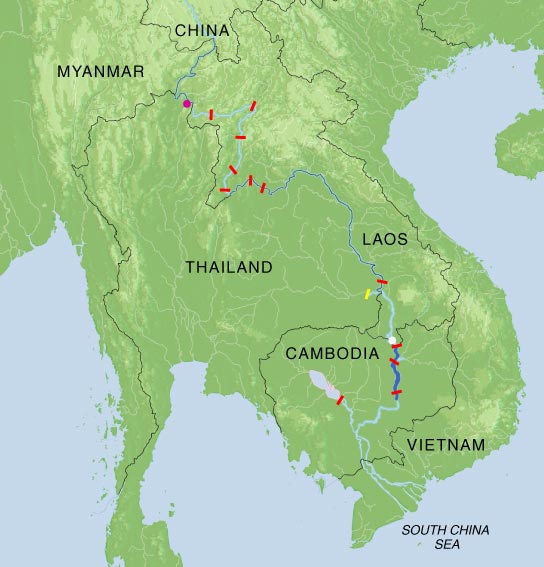
Why were silver-toned catfish a surprise? A few years before Hogan arrived in Thailand, Baird had reported that this species could be found in the South China Sea and also in southern Laos. Baird surmised that this migratory catfish might be anadromous, traveling from the marine waters of the South China Sea up the Mekong through Vietnam and Cambodia and into Laos, where they presumably spawned. His basic theory, along with Hogan's later observation of this species in Nong Khai, Thailand (about 1,600 kilometers upstream of the Mekong Delta), provided impetus for a study of the silver-toned catfish that could better document its travels. We (Hogan and Baird) began by carefully examining, of all things, small structures in its ears.
Hogan realized that this curious tactic might reveal migratory patterns after a chance meeting with Robert Kinzie and Richard Radtke of the University of Hawaii at Manoa. These investigators studied the migratory behavior of a different kind of fish, gobies, using a novel technique—analysis of strontium:calcium ratios in otoliths ("ear stones"). These small, hard deposits are found in the heads of all bony fish. Otoliths can be used to tell how old a specimen is, because they are built up of distinct layers that are deposited annually. Radtke and Kinzie found that otoliths can also indicate events that take place as the animals mature. In particular, the ratio of strontium to calcium in an otolith records whether the fish had been living in salt water or fresh water, because strontium concentrations in the ocean are one to two orders of magnitude greater than in rivers or streams.
With Radtke's offer of help, Hogan and Baird decided to use otoliths to test whether silver-toned catfish caught far inland had migrated up from the sea. The base of operation for this study was Hang Khone, a small village of about 45 families where Baird had been conducting community-based research on Mekong fisheries since 1991. This tiny enclave is located in the southernmost province of Laos, at the edge of Khone Falls, the Mekong's only mainstream waterfall, and a stone's throw from Cambodia. There, Hogan collected 36 specimens of silver-toned catfish for otolith analysis.
Hogan, Radtke and Baird found that the otoliths contained significant amounts of strontium—clear evidence that these fish had lived in salt water. Conversely, the analyses did not turn up elevated strontium concentrations in related species. These results helped bring the migratory pattern of this catfish into clearer focus. Baird had already documented silver-toned catfish living in the ocean from January through April. And Sophie Lenormand, a French graduate student working with the Asian Catfish Project in Vietnam, had determined that adults of this species move upstream of the estuarine zone in February or March. Higher yet on the river, in southern Laos, Baird had seen just adults weighing more than a kilogram or so—and only from May to October. It thus seems likely that in February and March the silver-toned catfish move from the sea into the river to spawn, reaching the Khone Falls, 719 kilometers upstream, in May and June, which is when the residents of Ban Hang Khone net 98 percent of their yearly haul of this fish.
This investigation kept Hogan well occupied through his year as a Fulbright student, but his interest in Mekong catfish did not end there. Hogan moved back to the United States in 1997 to begin study for a Ph.D. at the University of California, Davis, under the direction of another one of us (Moyle). A few years into Hogan's studies at Davis, Jake Vander Zanden joined Moyle's research group on a postdoctoral fellowship sponsored by The Nature Conservancy. Vander Zanden's specialty was stable isotope analysis, specifically the measurement of carbon and nitrogen isotopes, which can help to delineate food webs and energy flows in aquatic systems.
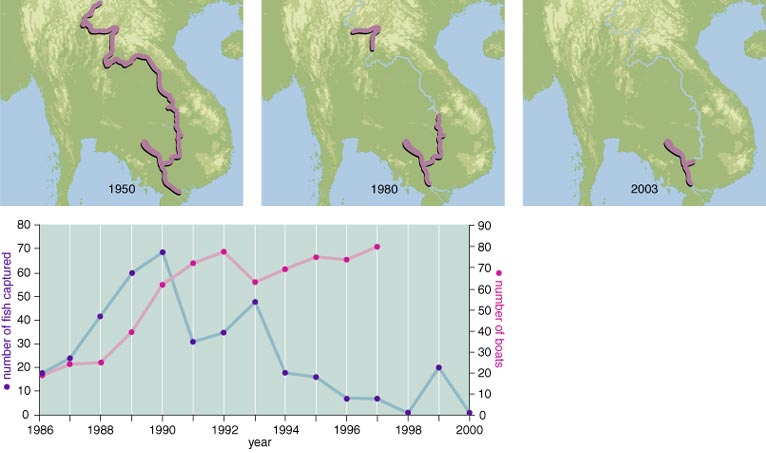
So it was quite natural that three of us (Hogan, Moyle and Vander Zanden) decided to use stable isotopes to fill out the story pieced together from the earlier otolith study of silver-toned catfish. We figured that such an analysis could readily tell us whether this big fish fattens up while at sea. And indeed, our results indicated that the flesh of this fish has an isotopic signature that reflects growth in a marine environment, something not seen in other related species of catfish.
Taken together, our analysis of catch data, strontium in otoliths and stable isotopes in muscle tissues provided ample evidence that the silver-toned catfish migrates long distances between fresh and salt water—the first documented case of anadromy in a Mekong River species. That is, we had fully confirmed the notion that this species was a Mekong "salmon," as Baird and Tyson Roberts of the Smithsonian Tropical Research Institute had dubbed it in 1995. Despite this success, it was clear early on that these chemical and isotopic methods wouldn't work to investigate the migratory habits of other species of Mekong catfish, which, as far as we knew, remain in fresh water throughout their lives. The inability of these techniques to chart such movements prompted Hogan to explore an entirely different avenue of investigation, one that he had earlier rejected as being too expensive and difficult—following some fish around.
At the time, fisheries biologists in the Mekong region were suggesting that fish migrate between the Mekong River and Tonle Sap Lake, the largest inland lake in Southeast Asia, which connects to the Mekong through a river also named Tonle Sap. In the dry season (November to February), this remarkable lake covers about 2,500 square kilometers. At the height of the rainy season (August), the lake area expands fourfold, and the maximum depth increases from 4 meters to 10. Life around the lake, including that of the local people, is uniquely adapted to this annual cycle. Fish use the flooded habitat to feed and to grow. The variety of landscapes, including inundated forests and fields, ephemeral streams and small satellite lakes, provides habitat for more than 100 kinds of fish and many more species of birds, reptiles and amphibians.
Every year at the end of the rainy season, the flow of the Tonle Sap River changes direction from north to south as the water begins to drain from the flooded forests and plains into the Mekong. With this outflow come millions of fish. (Residents take advantage this annual movement by fixing all manner of traps and nets in the lake and river to snare the migrating fish.) We wanted to determine where exactly these animals swim: Do they exit the Tonle Sap River and enter the Mekong? If so, where do they then travel? That is, do they move upstream or downstream? How far do they go?
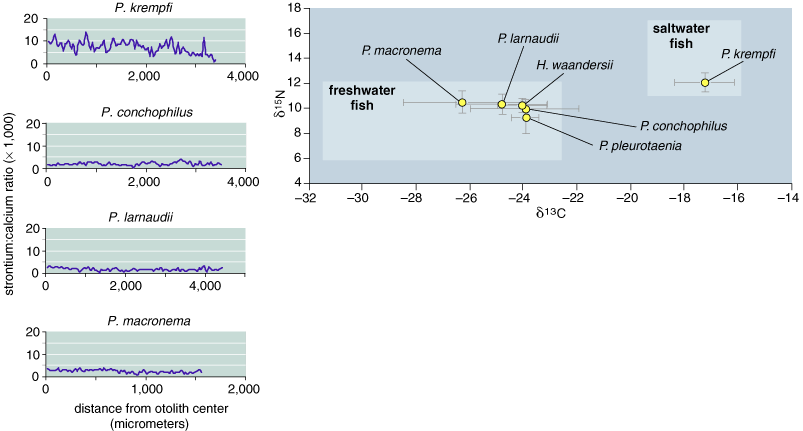
Underwater biotelemetry (fitting fish with acoustic or radio transmitters) seemed a good way to answer these questions. Biotelemetry systems have often been used to study fish migrations, to locate spawning and feeding grounds and to describe important seasonal habitat. But this high-tech strategy had never before been applied to chart fish migrations within the Mekong River basin, because most fisheries biologists believed that such tagging would not be fruitful in a river system so large and complex. Thankfully, Hogan was able to obtain support from the World Wildlife Fund to try this approach as well as the more common form of tagging—attaching plastic markers to fish.
For this study, Hogan and coworkers from the Cambodian Department of Fisheries collected live fish from a "bagnet" fishery located in the lower part of the Tonle Sap River near Phnom Penh. This particular fishery contains about 60 individual nets, each 120 meters long and 25 meters in diameter at the mouth. The first row of four side-by-side nets is located just outside the city, and the final phalanx is located some 35 kilometers to the north. This operation, like many other fisheries in the Tonle Sap River, runs from October to March, the period when water flows out of the great lake and into the Mekong and adjacent Bassac River.
Between November 6 and December 1, 2001, Hogan and his Cambodian colleagues outfitted two Mekong giant catfish and 11 river catfish with acoustic transmitters and plastic tags labeled "Please return to the Department of Fisheries." On the evening of December 9, the hydrophone we were trailing from our survey boat picked up signals from one of the tagged river catfish. We were cruising the Mekong, 20 kilometers upstream of its confluence with the Tonle Sap and Bassac rivers. This acoustic contact indicated that the fish had moved out of the Tonle Sap River and on up the Mekong. Although we never actually saw the fish, we were able to identify it (a 17-kilogram specimen we had tagged on the last day of November) using the unique pattern of beats programmed into its transmitter.

Two months later, this same fish gobbled up the baited hook of a local fisher approximately 300 kilometers upstream from Phnom Penh, which meant that it had traveled nearly 5 kilometers per day. Fishers have since recaptured several other tagged specimens in this same area (we learn about such catches promptly, because we provide a small reward for the return of our tags), suggesting that this migration route—from the Tonle Sap Lake, down the Tonle Sap River and on up the Mekong—is typical of river catfish.
Adult river catfish move into deep water areas of the Mekong River to survive the dry season. They then migrate upstream and spawn with the onset of the first heavy rains in May and June. Young fish float downstream with the rising water, eventually finding their way into inundated areas during the rainy season. These temporary wetlands, such as the flooded forest of the Tonle Sap Lake, act as rainy season nurseries for young fish of many other species as well.
While Hogan was tagging fish in the Tonle Sap River, he was becoming increasingly concerned about the plight of the giant catfish. Populations were clearly in a nosedive, yet this species continued to be caught, and there didn't seem to be any readily available means of regulating the fishery. Then in 1999 he and Nicolaas van Zalinge (head of the Mekong River Commission's Freshwater Capture Fisheries Program in Cambodia) hatched an idea: Why not buy any live specimens caught and release them? In Cambodia, fishermen capture giant catfish essentially by accident—as "bycatch" in the local bagnet fishery. These fish sell for very little: about fifty cents a kilogram. In Thailand, this species was in greater demand and thus was more expensive. A large fish there could fetch as much as $4,000. Although purchasing live Mekong giant catfish from local fishers clearly wasn't a long-term solution, starting a buy-and-release program seemed better than doing nothing.
The fishers were happy enough with our scheme, because we reimbursed them for the fish at market price. This approach was attractive to us, too, for a reason that went beyond just saving the few individuals that were caught: By purchasing, tagging and releasing giant catfish, we had a chance—albeit a very small one—to document any link that might exist between the specimens found upstream in Thailand and those found downstream in Cambodia.
Hogan figured that it would be straightforward to mark any live specimens caught with labeled plastic tags and then release the fish back into the river. Because he had developed contacts in both Thailand and Cambodia and was thus able to monitor both fisheries, he'd soon know when one of these marked fish was recaptured. And, obviously, if a fish tagged in Cambodia showed itself in Thailand, or vice versa, he'd have concrete evidence that these fish moved between the two locations (and past the proposed dam sites).
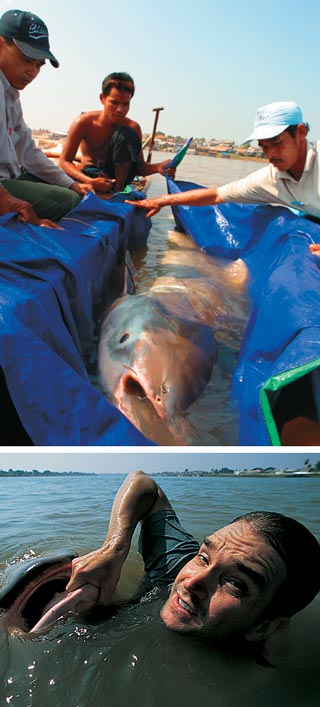
The study of migratory connectivity between these two populations was not just of academic interest. Indeed, developments taking place at the time made it seem especially important to understand what the catfish were doing: The upstream section of the river posed several threats to this species, the most obvious being the continued fishing in Chiang Khong, Thailand, where catches of the giant catfish were shrinking dramatically. Would a decline in the numbers of giant catfish upstream carry over to the downstream population?
To address such concerns, we needed to know whether the two stocks intermingled. But suppose no "northern" fish turned up down south (or vice versa)—would this finding, or rather lack of finding, mean that these two populations lived in isolation or merely that all of the tagged fish had been lucky enough to escape recapture? Knowing that the results of the tagging program might be ambiguous, Hogan joined the Genomics Variation Laboratory at the University of California, Davis, where with the help of another one of the authors (May) he developed genetic markers to study the Pangasiidae. Using tissue samples from the upstream and downstream stocks of the giant catfish, Hogan and May hoped to be able to determine whether these two populations mix.
In 2000, Hogan traveled to northern Thailand to observe the giant catfish fishery in Chiang Khong. His intent was to buy, tag and release the giant catfish captured there, as well as to obtain tissue samples. It was mid-April, the hottest time of the year. So Hogan found a small, well-shaded guesthouse and checked himself in for the month. Fishing records showed that most giant catfish were caught at about this time—and that the season for them was getting shorter each year. In 1992, for example, the season began with a catch on April 26 and lasted until June 9. In 1999, the season started on May 6 and finished just two weeks later. So for a month, Hogan waited on the patio of his guesthouse, walked down the street three times a day for a plate of fried rice, read books and worked on his laptop. But the locals caught none of the big fish.
As it turned out, 1999 was the last year that the catch of giant catfish in Chiang Khong could be termed a "fishery." After failing to locate any of these fish in 2000, Hogan returned there in 2001 and again in 2003, yet he never saw a specimen. During his last trip, Hogan spent a month interviewing local fishers about their practices and the catch of giant catfish. Everywhere the story was grim. In one village, locals said that the giant catfish had disappeared in 1960. In another community, they reported netting the last one 20 years ago. In Chiang Khong, the giant catfish held out only through 1999. Taken together, these accounts all pointed to the same conclusion—that the Mekong giant catfish was all but gone from northern Thailand.
Fortunately, downstream in Cambodia at least some giant catfish remained. And the Cambodian Department of Fisheries was eager to conserve its catfish stocks. So Hogan, with financing from the University of California and the National Geographic Conservation Trust, started a program to buy and release the giant catfish that survived capture, beginning in 2000. In all, he and colleagues in the Cambodian Department of Fisheries have purchased 21 adult giant catfish—about 80 percent of the total reported catch—letting them slip back into the Tonle Sap River. (They are confident that they hear about most captures of giant catfish, both because news of these events travels quickly on the river and because their project has garnered enough publicity that most fishers know to contact them.) Hogan and his Cambodian counterparts do the same with 10 other vulnerable species, including the giant carp (Catlocarpio siamensis), the giant sting ray (Himantura chaophraya) and the river catfish. In all, they have bought, tagged, and released approximately 5,000 fish.
But with no giant catfish to examine from the Thai sections of the Mekong, Hogan had no way to verify whether the tagged "Cambodian" fish migrate upstream, and he, Moyle and May had no way to compare genetic makeup between the two populations, if indeed there still is an upstream population worth talking about.
Despite this setback, we don't consider the investigation a total washout—far from it. Our genetics work has proved valuable for other reasons. For one, our results can be used to study the genetics of other catfish species. And the genetic markers that we developed also allowed us to examine the diversity of stocks bred in captivity and to anticipate the effect of release of hatchery-raised fish into the wild.
Hatchery fish were a concern because the Thai Department of Fisheries was pursuing an artificial breeding program for the giant catfish. Since 1985, thousands of giant catfish that were artificially reared have been stocked into the Mekong. The site of their release is almost certainly spawning habitat for their wild cousins, raising concern about the loss of genetic diversity that might result from having large numbers of stocked fish overwhelming the small natural population. Loss of genetic diversity would further limit the ability of the already-rare catfish to adapt to changing conditions.
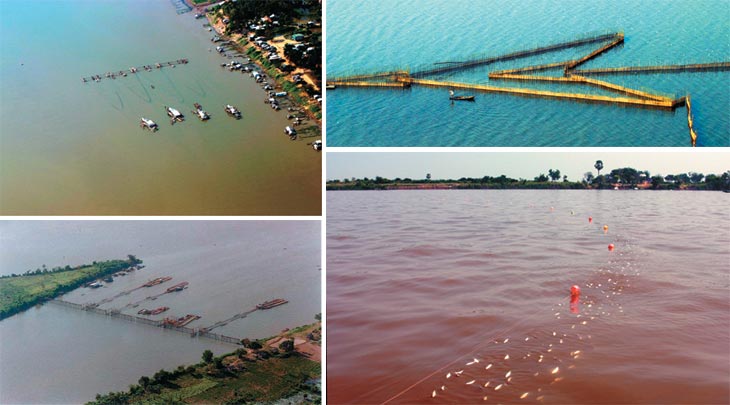
Unfortunately, the program may be doing more harm than good. For example, in 1999, the largest catch of Mekong giant catfish in northern Thailand in the last ten years (almost two dozen fish) was sacrificed to supply eggs and milt for the artificial propagation. Genetic analysis of the progeny indicated that roughly 95 percent shared the same two parents. More than 10,000 of these fingerlings were released in 2001. Although we applaud the Thai government's desire to rescue the giant catfish from the verge of extinction, the current method of brood collection and captive breeding seems likely to erode the genetic diversity remaining in the wild Cambodian population while also depleting the wild Thai population.
Will the southern population ultimately suffer the same fate as the one in the north? Perhaps. But we prefer to be more optimistic. Last year there were several positive steps that may help the Mekong giant catfish and other threatened freshwater species of the region. For example, in November the World Conservation Union officially classified the Mekong giant catfish as critically endangered. This designation is reserved for Earth's most threatened species—ones living in only a single location, numbering less than 50 wild individuals or suffering rapid, dramatic population decline. Although nobody wants to celebrate that this animal is in grave danger, the new classification is, in fact, good news for the giant catfish, because it raises awareness about the necessity for immediate protection.
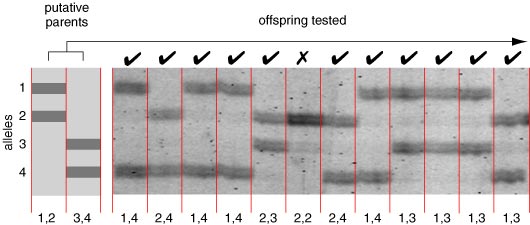
David Schneider
Another recent development shows how important it is to get the word out that this fish is in trouble. Participants in the Mekong Wetlands Biodiversity Program, an effort of the World Conservation Union, together with people working for that organization's Bangkok-based Water and Nature Initiative, recently conducted an assessment of fish biodiversity, along with a study of the community fisheries in northern Laos and Thailand. These efforts produced evidence that the Mekong giant catfish spawns in the area where rapids were being blasted as part of the Upper Mekong Navigation Improvement Project, an initiative intended to spur the local economies. Since publication of these results, plans for blasting more of the river rapids in Thailand have been postponed. Although the reasons for that postponement are manifold, one hopes that icreased awareness of the environmental disruptions the blasting causes will help to keep the project on hold.
Another recent triumph for the Mekong giant catfish is that one of us (Hogan) has just completed Samnang and the Giant Catfish, a children's primer on the ecology and conservation of aquatic life in the Mekong River. The publisher, a Cambodian organization called Save Cambodia's Wildlife, is distributing the book to thousands of youngsters throughout that country. If the big fish holds on for long enough, perhaps the book will raise awareness in the next generation of Cambodians about the value of conserving this and other endangered fish species of the Mekong.
Although much remains to be learned about the ecology of the migratory catfish inhabiting the Mekong, enough good science is now available to forge a strategy for the sustainable management of these inland fisheries. This broad survey of the problem isn't the place to detail prescriptions for better fisheries management, but we can at least outline what would be involved.
First, maintaining the connectivity between spawning grounds and nursing areas is absolutely critical, in part because many seasonal fisheries are based on the catch of migratory fish. It is important to avoid what happened on the Mun River, the Mekong's largest tributary in Thailand, where a dam blocked the upstream migration of many fish, especially catfish, most of which cannot navigate the ladder constructed to allow them to climb over this obstruction. Not surprisingly, the local catch of migratory species plummeted after construction of the dam. The resultant political fallout has been widespread and long lasting: Fishers protested, and eventually occupied, the dam site in 2000, and in 2001 the ongoing opposition prompted the government to consider removing the dam. In the end, authorities decided to operate the dam at reduced capacity (opening the massive flood gates for four months of the year), in hopes of bolstering stocks of migratory fish.
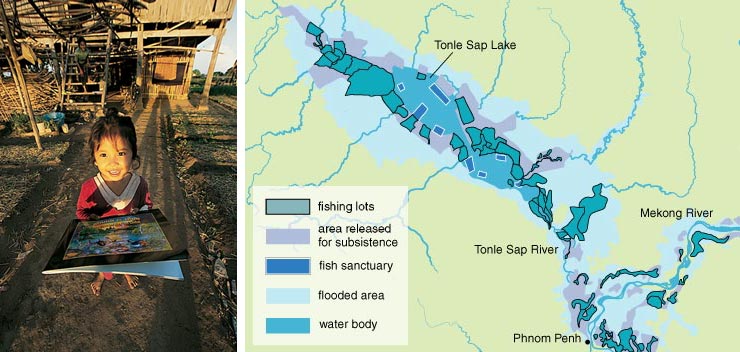
If the Mun River Dam is any indication, planners should be cautious about proposals for mainstream dams on the Mekong River, recognizing that no workable design yet exists to mitigate the harm these dams bring to migratory fish. Dams would also alter the natural variation in river flow, which is critical to maintain, because the behavior of migratory fish (and the people who depend on them for a livelihood) is closely tied to these seasonal changes.
Because the central governments have only limited presence in the rural areas where the fishing takes place, management of this natural resource must begin at the local level. But with fish migrating between Vietnam, Thailand, Laos and Cambodia, action at the local, or even the national level, is not sufficient. The fisheries of the Mekong need to be managed as a transboundary resource. And the authorities drafting the regulations need to be aware that in a mixed-species fishery such as this, slowly maturing species are especially vulnerable to over-exploitation—and thus to extinction. That is, regulations that are able to maintain the total catch in a multi-species fishery can nonetheless lead to severe declines among vulnerable groups, most notably large-bodied, migratory fish.
Ultimately, the preservation of such species must be considered not only as a matter of fisheries management but also as a conservation issue. The growing list of threatened migratory fish (P. gigas, P. sanitwongsei, P. hypophthalmus, P. jullieni, C. siamensis) demonstrates the need for precautionary actions to aid their conservation and for greater efforts to assess their status.
One option that acknowledges the shortcomings of typical approaches to fisheries management would be to pursue an idea recently championed by Harvard entomologist E. O. Wilson: conservation concessions. Adopting this tactic on the Mekong River would blend something similar to what can now be found on land in several places (including Guyana, Suriname, Bolivia, Peru and the Congo) with the situation in various marine protected areas. The idea is to purchase the right to fish commercially in a specified area but not to exercise it. These "fishing rights" would then become nonfishing rights: the power to halt large-scale commercial fishing in certain areas in favor of small-scale subsistence fishers—and fish. Some people living along the Mekong already use a similar tactic on a small scale, forbidding fishing in reaches of the river adjacent to their villages.
This strategy offers a direct method to protect these natural resources for the long term. If carried out effectively, conservation concessions have the potential to boost fisheries production elsewhere, by increasing the spawning stock while at the same time providing revenue to the governments that issue them, new jobs for fisheries officials (to enforce regulations within the concessions) and opportunities for community participation in their management. Such concessions could either be established with revenues from ecotourism or with funds from organizations such as the Asian Development Bank or the Global Environment Facility, which are both currently involved in large-scale projects in the Mekong River basin.
Whether or not such conservation concessions are quickly established, a complete moratorium on the catch of Mekong giant catfish, including those caught incidentally, is urgently needed. The remaining population simply cannot support a fishery at this time. What is more, the ban needs to extend to wild fish caught for artificial breeding. The Thai Department of Fisheries should breed existing captive stocks to supply the commercial aquaculture sector. The captive stocks should also be used to develop a breeding program that produces greater genetic diversity in the fish that are to be introduced into the wild. Even if this strategy fails, effective conservation measures in Cambodia may allow the wild population there to bounce back, and this "downstream" stock might then replenish other stretches of the river.
It's obvious that in some spots, notably in China and along some tributaries, the river ecosystem is deteriorating rapidly. But when considering the Mekong River as a whole, there is still ample reason to be optimistic. So far, the main channel of the Mekong river has not been dammed below China. This waterway remains relatively unpolluted, and fishers here and on many of the tributaries are still able to capture phenomenal quantities—some 16 percent of the world's total freshwater catch. The countries of the lower Mekong (Thailand, Laos, Cambodia and Vietnam) have shown resolve to work together for the sustainable development of their shared aquatic resources. Perhaps they can accomplish something that we have largely failed to do in North America: develop truly sustainable fisheries while protecting local biodiversity.
Click "American Scientist" to access home page
American Scientist Comments and Discussion
To discuss our articles or comment on them, please share them and tag American Scientist on social media platforms. Here are links to our profiles on Twitter, Facebook, and LinkedIn.
If we re-share your post, we will moderate comments/discussion following our comments policy.